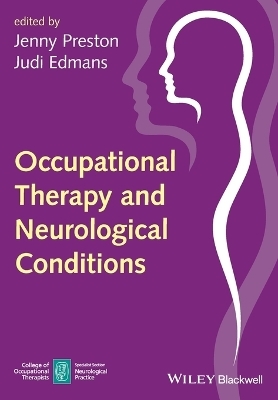
Occupational Therapy and Neurological Conditions
John Wiley & Sons Inc (Verlag)
978-1-118-93611-5 (ISBN)
- Written from an occupational perspective and for the needs of occupational therapists and their clients
- Ideal for students and newly qualified practitioners to provide them with an overview of this key area of practice
- Includes case studies to place material within the context of practice
- Officially endorsed by the College of Occupational Therapists
Jenny Preston, PhD, BSc (Hons), DipCOT is a Consultant Occupational Therapist within NHS Ayrshire & Arran, and Glasgow Caledonian University. She has over 30 years clinical experience working with people with a range of neurological conditions, and is currently Chair of the College of Occupational Therapists Specialist Section Neurological Practice.Judi Edmans, PhD, MPhil, DipCOT, FCOT is a Senior Research Fellow in the Division of Rehabilitation and Ageing at the University of Nottingham. She has been qualified for over 35 years, has worked mainly in stroke both in clinical practice and research and is the editor of the book Occupational Therapy and Stroke.
List of figures and tables, viii
List of contributors, x
Academic foreword, xi
Service user foreword, xii
Preface, xiii
Acknowledgements, xiv
1 Introduction, 1
1.1 Economic impact of long?]term neurological conditions, 1
1.2 Definition of long?]term neurological conditions, 2
1.3 International Classification of Functioning, Disability and Health, 2
1.4 Huntington's disease, 4
1.5 Motor neurone disease, 9
1.6 Multiple sclerosis, 13
1.7 Parkinson's, 18
1.8 Self?]evaluation questions, 22
References, 22
2 Delivering good quality, safe and effective care, 24
2.1 Introduction, 24
2.2 The strategic context, 24
2.3 Evidence?]based practice, 27
2.4 Clinical guidelines, 33
2.5 Practice guidance, 33
2.6 Client expertise in evidence?]based practice, 35
2.7 Quality improvement, 36
2.8 Health economic evaluation, 39
2.9 Professional standards of practice, 40
2.10 CPD and lifelong learning, 40
2.11 Self?]evaluation questions, 42
References, 43
3 Person?]centredness and long?]term neurological conditions, 46
3.1 Introduction, 46
3.2 Person?]centredness, 46
3.3 Client?]centred practice, 48
3.4 Self?]management, 55
3.5 Co-production, 57
3.6 Evaluating your practice, 58
3.7 Self-evaluation questions, 59
References, 60
4 Theoretical basis, 63
4.1 Introduction, 63
4.2 Definitions of occupational therapy, 63
4.3 Central philosophy of occupational therapy, 65
4.4 Core professional reasoning skills, 65
4.5 Conceptual models of occupational therapy practice, 69
4.6 Frames of reference, 78
4.7 Context?]dependent practice skills, 81
4.8 Self?]evaluation questions, 83
References, 83
5 Occupation and long?]term neurological conditions, 86
5.1 Introduction, 86
5.2 Defining occupation, 86
5.3 Occupational patterns, 87
5.4 Doing, being, becoming and belonging, 88
5.5 Occupational dysfunction, 93
5.6 Occupational adaptation, 96
5.7 Defining occupational goals, 98
5.8 Self?]evaluation questions, 99
References, 99
6 Identifying occupational performance enablers and deficits, 101
6.1 Introduction, 101
6.2 What is measurement?, 101
6.3 What are occupational therapy outcomes?, 102
6.4 Selecting the right measure, 103
6.5 Commonly used measures in neurological rehabilitation, 106
6.6 Disease?]specific measures, 111
6.7 Self?]evaluation questions, 118
References, 118
7 Occupational therapy intervention, 122
7.1 Introduction, 122
7.2 Activities of daily living, 123
7.3 Fatigue management, 124
7.4 Cognitive rehabilitation, 126
7.5 Anxiety management, 129
7.6 Falls management, 135
7.7 Pain management, 137
7.8 Managing tremor, 140
7.9 Sleep, 143
7.10 Sexual relationships and intimacy, 144
7.11 Self evaluation questions, 147
References, 147
8 Using technology to support participation, 150
8.1 Introduction, 150
8.2 Environmental characteristics and occupational performance, 150
8.3 Environmental adaptations, 151
8.4 Assistive technology, 152
8.5 Assistive devices, 152
8.6 Housing adaptations, 154
8.7 Seating and postural management, 156
8.8 Management of posture and positioning in sitting, 158
8.9 Management of posture and positioning in lying, 160
8.10 Splinting, 162
8.11 Electronic assistive technology, 163
8.12 Self?]evaluation questions, 168
References, 168
9 Living with a long?]term neurological condition, 171
9.1 Introduction, 171
9.2 Transitions theory, 171
9.3 Illness experiences, 172
9.4 Rehabilitation and recovery, 173
9.5 Lifespan transitions, 174
9.6 Social and cultural transitions, 175
9.7 Caregiving, 183
9.8 Psychosocial adjustment, 185
9.9 Self?]evaluation questions, 189
References, 189
10 Planning for the future, 194
10.1 Introduction, 194
10.2 Disease progression, 194
10.3 The nature of occupation in death and dying, 197
10.4 Facilitation of meaning, quality of life and well?]being, 198
10.5 Spirituality, 198
10.6 Therapeutic use of self, 199
10.7 Advance care planning, 200
10.8 Conclusion, 209
10.9 Self?]evaluation questions, 209
References, 210
Index, 212
| Erscheinungsdatum | 10.05.2016 |
|---|---|
| Verlagsort | New York |
| Sprache | englisch |
| Maße | 171 x 242 mm |
| Gewicht | 460 g |
| Einbandart | kartoniert |
| Themenwelt | Medizin / Pharmazie ► Medizinische Fachgebiete ► Neurologie |
| Medizin / Pharmazie ► Physiotherapie / Ergotherapie ► Ergotherapie | |
| ISBN-10 | 1-118-93611-6 / 1118936116 |
| ISBN-13 | 978-1-118-93611-5 / 9781118936115 |
| Zustand | Neuware |
| Informationen gemäß Produktsicherheitsverordnung (GPSR) | |
| Haben Sie eine Frage zum Produkt? |
aus dem Bereich


